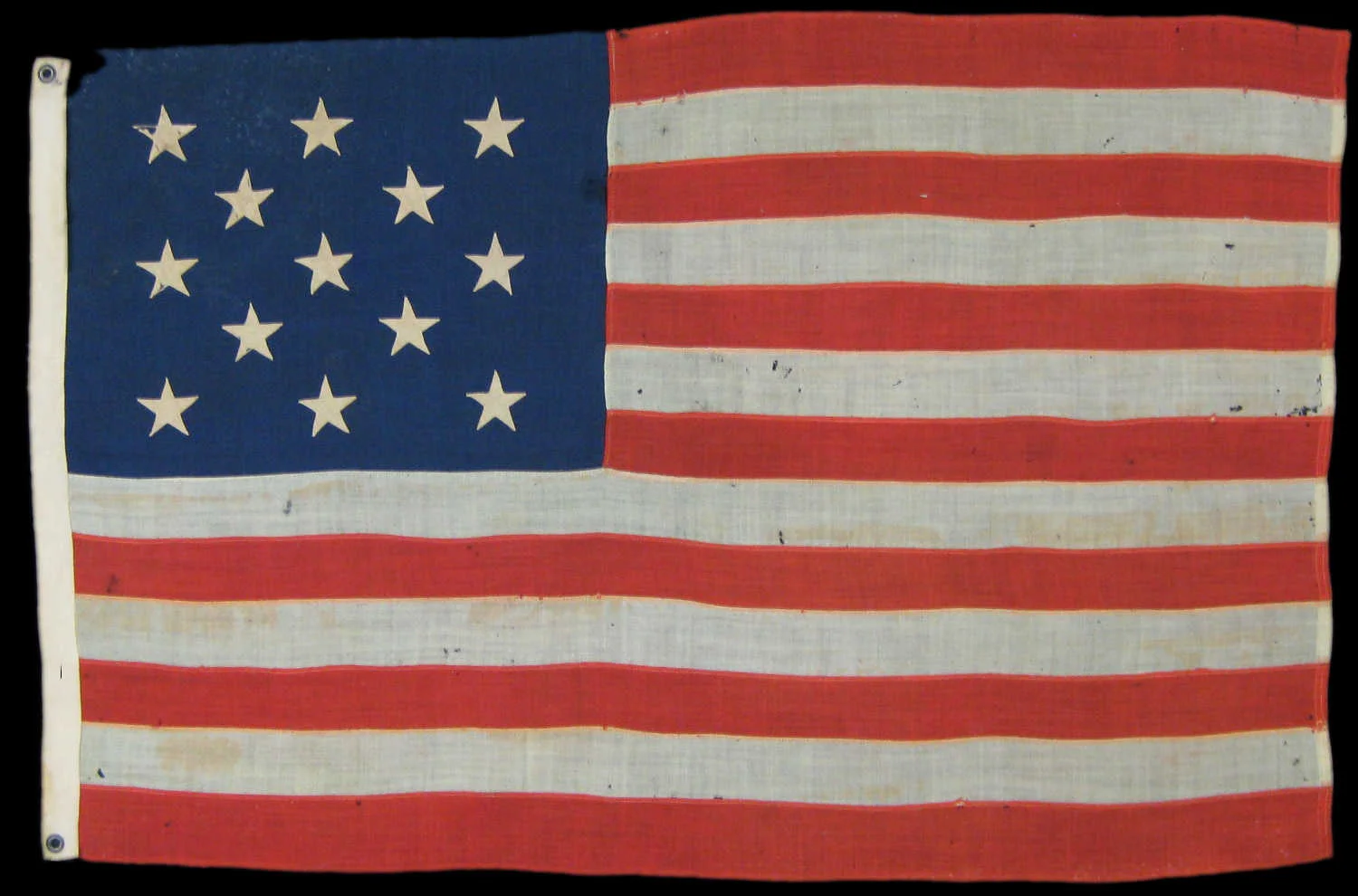13 Star Antique Flag with 3-2-3-2-3 Star Pattern | Circa 1895-1926
13 Star Antique Flag with 3-2-3-2-3 Star Pattern | Circa 1895-1926
Frame Size (H x L): 39.5” x 56.5”
Flag Size (H x L): 31” x 47”
Offered is a thirteen-star flag. Its stripes and canton are made of wool. And its stars are made of cotton and are sewn to both sides of the canton (i.e., double appliqued), using a zig-zag stitch. In August of 1889, Henry Bowman filed a patent application for a "method of making flags," which later issued as an enforceable patent in February of 1892 (US 469,395). His patent covered the zig-zag stitch, a very distinct back-and-forth sewing method primarily for affixing stars on flags. One advantage of the zig-zag stitch is that it can be used to bind the edges of roughly cut stars. Mr. Bowman practiced his invention, and even marked the hoist of his flags with "Patented Feb.23.1892." Despite this, many flag makers were undeterred, and Mr. Bowman had to bring a lawsuit against Walter DeGrauw and others for the alleged infringement of his patent. Ultimately, Mr. Bowman's patent was found invalid based on similar stitching techniques in the prior art, further opening the flood gates for flag maker's to utilize the zig-zag stitch. For more information, we highly recommend reading the entire legal opinion, as it provides a fascinating review of the state of the art in flag making in the 1880s. The filing date of the patent, 1889, provides a fantastic "not earlier than date" when one encounters this kind of stitching on a particular flag. In the case of this flag, because of the zig-zag stitching and the weave of the wool, it likely dates to between 1895 and the 1920s.
The 3-2-3-2-3 pattern, which looks like a diamond of stars surrounded by corner stars, is sometimes referred to as the Hopkinson pattern after Francis Hopkinson. While no one knows for sure, it may have been the star pattern for the first flag (not the Betsy Ross pattern). While it is clear that Betsy Ross made flags in in Philadelphia in the 1770's, there is no evidence that she made the first flag in the form of letters, articles, journals, or records. Historians generally do not accept that Ross designed or made the first flag, and instead support that Hopkinson designed it. Hopkinson was a member of the Continental Congress, a signer of the Declaration of Independence, and a lawyer. The evidence supporting Hopkinson's role includes his claim to Congress, for payment, for having furnished the design of "the flag of the United States of America." Hopkinson asked to be paid in "a Quarter Cask of public wine" and later asked to be paid in $1,440 in Continental paper. Both payments, however, were refused by Congress. Congress agreed that Hopkinson had a role in the design, but refused to pay him because he "consulted" other men.
The original use of the thirteen-star flag dates to June 14th, 1777, the time at which the Continental Congress adopted a resolution creating the first official flag. The resolution stated, “Resolved, that the flag of the United States be made of thirteen stripes, alternate red and white, that the union be thirteen stars, white on a blue field, representing a new constellation.” Thirteen-star flags were official from 1777-1795, but have been in use ever since.
Small US Navy boats used it as the ensign from 1795 until 1916. Thirteen-star flags were also flown at the time of George Washington’s death in 1799 and to celebrate the nation’s 50th anniversary in 1824. They were also flown in 1824 in honor of General Lafayette’s return to the US for his nationwide tour. Celebrations for his Revolutionary War service were held in New York, Boston, and Philadelphia, along with many locations in the southern and western states.
Further, thirteen-star flags were also common during the Mexican War in 1846-1848 and the Civil War in 1861-1865. They were both relatively close in time to the revolution, and were very patriotic times, particularly during the Civil War time period when flag use became much more common than had ever previously been the case. Thirteen-star flags were also flown during the centennial celebrations, which were held across the country and, most notably, in Philadelphia at the Centennial International Exhibition.
Conservation Process: This flag was hand sewn to silk organza, and both were hand sewn to cotton fabric. The silk organza provides a strong layer of protection and a professional appearance. The flag, the silk organza, and the cotton fabric were then hand sewn to a mounting board. To prevent the black dye in the cotton fabric from seeping into the flag, it was first washed in a standard wash and then in a dye setting wash. The flag is positioned behind Conservation Clear Acrylic (standard) or behind Optium Museum Acrylic (per request).
Frame: This offering is in our Large Gold Frame.
Condition Report: The flag has some minor mothing, and some bleeding of red into the white stripes. Still it presents wonderfully, and many collectors prefer flags that show their use and age.
Collectability Level: The Great – Perfect for Rising Collectors
Date of Origin: 1895-1926
Number of Stars: 13
Associated War: Spanish-American War (1898)
Associated State: Original 13 Colonies


